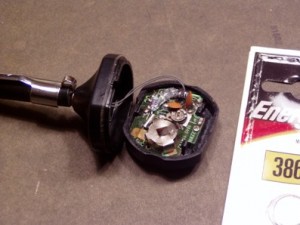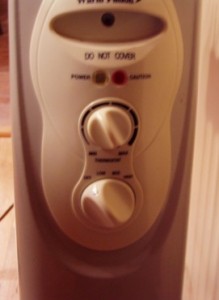 One of the aspects of our consumer economy is frankly the way we treat everything as disposable. Whether it’s clothing, kitchen equipment, or furniture, a lot of it is made so badly and cheaply that fixing things that go wrong is either impossible (you can’t get to the guts of the thing) or the parts to fix it with are more expensive than what you paid for it. But sometimes it’s worth it. Here are two examples:
One of the aspects of our consumer economy is frankly the way we treat everything as disposable. Whether it’s clothing, kitchen equipment, or furniture, a lot of it is made so badly and cheaply that fixing things that go wrong is either impossible (you can’t get to the guts of the thing) or the parts to fix it with are more expensive than what you paid for it. But sometimes it’s worth it. Here are two examples:
Meat thermometer. This particular probe is actually no longer being manufactured by Taylor. The closest level of digital meat probe that they have is this one, which as you can see from the link at Amazon, is $25+. This new one has more bells and whistles; it folds up and it runs on 2 AA batteries. Taylor Meat Probe
We actually own several of these more primitive digital probes and one of them is my go-to SOIL thermometer. When I went to use it the other day (to write a post, actually), I discovered it did not work anymore. This is a simple piece of equipment and it’s battery operated, so that chances that something other than a dead battery was the issue were pretty small. My biggest issue was actually finding what other batteries could be exchanged for the battery which was inside the case. I found my exchange here. battery exchange chart
and was able to find the right battery at my local drug store.
Fixing this probe was simplicity itself:
Open up the case using the blade of a knife or a dime.
Using something non-metal, like the top of a pen, push out the battery, which was held in place by a metal clip.
Using a cotton topped swab, clean out the area (not with acetone or anything like that because it IS plastic in there) where the battery WAS.
Using fingers or something plastic (the end of that pen again), push the battery, business side down(that’s the part on any battery that sticks up — all batteries have a flat side and a side with a protrusion on it; the ‘sticky-outy thing’ is the business end of a battery).
Clip the case back together.
Wa-la. Working meat probe. The battery cost me $5.00; I’m sure there are sites on the internet where I could have gotten it cheaper but the shipping would have probably brought it over. But it kept another piece of something out of the landfill and I fixed it myself.
Example Number Two:
Oil Filled Radiator Heater. I love these things; we have two that we use to keep the odd corners of Chez Siberia warm when people are there and the regular heat does not go there (we have an extension on the house where it’s just tooooo far away from the furnace. No amount of insulating ductwork or fans can keep the air warm when it gets to that place. It’s just easier to have a heater on when a person is working in that area of the house. We also use them out in the workroom of the garage, basement, etc.). This one ‘died’ last winter and we’d never gotten around to seeing what we could do with it. Unfortunately, my son started working on it and by the time I could get my camera out, he’d fixed the problem but I’ll describe it to you so that you can fix this yourself.
There are two ‘points of failure’ in these units:
The electronics themselves.
The controls for the electronics.
Considering that all controls are made out of cheap plastic, the chances that it was the electronics was the point of failure was actually pretty small.
 Here is what the controller looks like — this one comes off my stove but all knobs are like this. In this oil-filled radiator, there are two; one which operates like a rheostat and just rotates through Min-Max and the other one, which actually is involved with the power itself, which clicks through off/low/medium/high.
Here is what the controller looks like — this one comes off my stove but all knobs are like this. In this oil-filled radiator, there are two; one which operates like a rheostat and just rotates through Min-Max and the other one, which actually is involved with the power itself, which clicks through off/low/medium/high.
 Again, like the probe, the trick is to get at the business end of things, which is underneath this cover. At the top of the cover, in an oval depression above the top control knob, is a Phillips head ™ screw. Undoing that allowed the entire front plate to be loosened and taken off so that my son could look at ‘where the rubber meets the road’, knobwise. The lower knob, the one involved with the power itself, once he took it off, showed that the inner tube of the knob (see the photo of the stove knob? They are all like that; that inner tube clips over a metal rod that is the switch that rotates from off to on/low/medium etc.) had a crack in both sides. It no longer gripped the metal rod so you could not turn the power on. He repaired the tube with some packing and electrical tape, made it tight enough on the inside of the tube to grip the metal rod, and turned the radiator back into a functioning appliance. If the knob had not been salvageable, he could have taken it to an appliance store and found a knob that was the same size to replace it with. It might now have exactly matched in terms of shape or color but we’re talking about an item which is not exactly sitting out all the time or used in a place where appearance is exactly a crucial element.
Again, like the probe, the trick is to get at the business end of things, which is underneath this cover. At the top of the cover, in an oval depression above the top control knob, is a Phillips head ™ screw. Undoing that allowed the entire front plate to be loosened and taken off so that my son could look at ‘where the rubber meets the road’, knobwise. The lower knob, the one involved with the power itself, once he took it off, showed that the inner tube of the knob (see the photo of the stove knob? They are all like that; that inner tube clips over a metal rod that is the switch that rotates from off to on/low/medium etc.) had a crack in both sides. It no longer gripped the metal rod so you could not turn the power on. He repaired the tube with some packing and electrical tape, made it tight enough on the inside of the tube to grip the metal rod, and turned the radiator back into a functioning appliance. If the knob had not been salvageable, he could have taken it to an appliance store and found a knob that was the same size to replace it with. It might now have exactly matched in terms of shape or color but we’re talking about an item which is not exactly sitting out all the time or used in a place where appearance is exactly a crucial element.
Again — this is not necessarily an expensive item; you can pick these up at home/garden centers, hardware stores, Amazon, etc. for $45 on up to several hundred dollars. But with literally less than 10 minutes work, my son, with a screw driver, some tape and a little ingenuity, turned something that would have ended up in the landfill, back into use. The only point of fear someone should have about trying to fix something like this is to first make sure the item is unplugged from the electrical outlet first.
